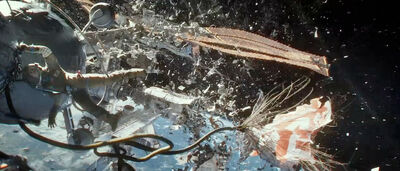
The satellite debris destroys the ISS.
The Kessler syndrome (also called the Kessler effect, collisional cascading or ablation cascade), proposed by the NASA scientist Donald J. Kessler in 1978, is a scenario in which the density of objects in low Earth orbit (LEO) is high enough that collisions between objects could cause a cascade—each collision generating space debris which increases the likelihood of further collisions. One implication is that the distribution of debris in orbit could render space exploration, and even the use of satellites, unfeasible for many generations.
Gravity features a Kessler syndrome catastrophe as the event which sets the plot in motion.
Description
Every satellite, space probe, and manned mission has the potential to create space debris. A cascading Kessler syndrome becomes more likely as satellites in orbit increase in number and old satellites become inoperative. The most commonly used orbits for both manned and unmanned space vehicles are low Earth orbits, which cover an altitude range low enough for residual air drag to be sufficient to help keep the zone clear. Collisions that occur in this altitude range are also less of an issue because the directions into which the fragments fly and/or their lower specific energy often result in orbits intersecting with Earth or having perigee below this altitude. Orbital decay is much slower at altitudes where atmospheric drag is insignificant. Slight atmospheric drag, lunar perturbation, and solar wind drag can gradually bring debris down to lower altitudes where fragments finally reenter, but this process can take millennia at very high altitudes.
Implications
Image made from models used to track debris in Earth orbit. The Kessler syndrome is especially insidious because of the "domino effect" and "feedback runaway" wherein impacts between objects of sizable mass spalls off debris from the force of collision. The shrapnel can then hit other objects, creating even more space debris: if a large enough collision or explosion were to occur, such as between a space station and a defunct satellite, or as the result of hostile actions in space, then the resulting debris cascade could render low Earth orbit essentially impassable.
Avoidance and reduction
Designers of a new vehicle or satellite are frequently required to demonstrate that it can be safely disposed of at the end of its life, for example by use of a controlled atmospheric reentry system or a boost into a graveyard orbit. One technology proposed to help deal with fragments from 1 cm to 10 cm in size is the laser broom, a proposed multimegawatt land-based laser that could deorbit debris: the side of the debris hit by the laser would ablate and create a thrust that would change the eccentricity of the remains of the fragment until it would re-enter harmlessly.
Potential trigger
The Envisat satellite is a large, inactive satellite with a mass of 8,211 kg (8.211 t) that drifts at 785 km (488 mi), an altitude where the debris environment is the greatest—2 catalogued objects can be expected to pass within about 200 meters of Envisat every year—and likely to increase. It could easily become a major debris contributor from a collision during the next 150 years that it will remain in orbit.
Fictional and dramatic representations
- An ablation cascade is a key plot point in Ken MacLeod's future history novel The Sky Road.
- An offshoot of humanity uses asteroid debris to "close the sky" in Peter F. Hamilton's stand-alone sci fi novel Fallen Dragon.
- The Japanese manga/anime Planetes revolves around a team of space debris collectors based in the debris craft Toy Box in the year 2075. A Kessler syndrome scenario is referenced directly when a "Space Defense Front" terrorist group attempts to ram a satellite into a space station, thus cutting off the world's economic powers from space-borne resources.
- In the book World War Z, the Chinese are revealed to have a small space station, believed to be unmanned. When crew from the International Space Station board it after a brief radio message, they find the Chinese crew are both dead, one having killed the other, and that the entire station was a bomb, set up to explode and cause a cascade effect denying all nations the use of space.